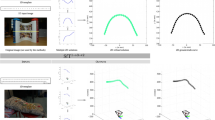Abstract
A generalized model, called the homotopy model, is presented to reconstruct surfaces from cross-sectional data of objects using a homotopy to generate surfaces connecting consecutive contours. The homotopy model consists of continuous toroidal graph representation and homotopic generation of surfaces from the representation. It is shown that the homotopy model includes triangulation as a special case and generates smooth parametric surfaces from contour-line definitions using homotopy. The model can be applied to contours represented by parametric curves as well as linear line segments. First, a heuristic method that finds the optimal path on the toroidal graph is presented. Then the toroidal graph is expanded to a continuous version. Finally, homotopy is used for reconstructing parametric surfaces from the toroidal graph representation. A loft surface is also a special case of homotopy, a straight-line homotopy. Homotopy that corresponds to the cardinal spline surface is also introduced. Three-dimensional surface reconstruction of human auditory surface reconstruction of human auditory ossicles illustrates the advantages of the homotopy model over the others.
Similar content being viewed by others
References
Armstrong MA (1983) Basic topology. Springer, New York Berlin Heidelberg Tokyo, p 88, pp 103–105; p 169
Boissonnat JD (1988) Shape reconstruction from planar cross sections. Comput Vision Graph Image Processing 41(1):1–29
Christiansen HN, Sederberg TW (1978) Conversion of complex contour line definitions into polygonal element mosaics. Comput Graph (SIGGRAPH Proc) 12:187–192
Clark JH (1981) parametric curves, surfaces and volumes in computer graphics and computer-aided geometric design. Computer Systems Laboratory, Technical Report No. 221, Stanford University
Fuchs H, Kedem ZM, Uselton SP (1977) Optimal surface reconstruction from planar contours. Commun ACM 20 (10):693–702
Ganapathy S, Dennehy TG (1982) A new general triangulation method for planar contours. Comput Graph (ACM SIGGRAPH Proc) 16:69–75
Herman GT, Liv HK (1979) Three-dimensional display of human organs from computer tomograms. Comput Graph Image Processing 9:1–21
Kaneda K, Harada K, Nakamae E, Yasuda M, Sato AG (1987) Reconstruction and semitransparent display method for observing inner structure of an object consisting of multiple surfaces. In: Kunii TL (ed) Computer graphics. Springer, Tokyo Berlin Heidelberg New York London Paris, pp 367–380
Mao X, Kunii TL, Fujishiro I, Noma T (1987) Hierarchical representations of 2D/3D gray-scale images and their 2D/3D two-way conversion. IEEE Comput Graph Appl 7(6):37–44
Meagher DJ (1982) Geometric modeling using octree-encoding. Comput Graph Image Processing 19:129–147
Merickel M (1988) 3D reconstruction: the registration problem. Comput Vision Graph Image Processing 42:206–219
Mitiche A, Aggarwal JK (1983) Contour registration by shapespecific points for shape matching. Comput Vision Graph Image Processing 22:396–408
Nomura, Y, Okuno T, Hara M, Shinagawa Y, Kunii TL (1989) Walking through a human ear. Acta Otolaryngol (Stockh) 107:366–370
Shinagawa Y, Kunii TL, Nomura Y, Okuno T, Young Y (1990) Automating view function generation for walk-through animation using a Reeb graph. In: Magnenat-Thalmann N, Thalmann D (eds) Computer Animation. Springer, Tokyo Berlin Heidelberg New York London Paris Hong Kong, pp 227–237
Tam Y, Davis WA (1988) Display of 3D medical images. Graphics Interface' 88, pp 78–86
Preparate FP, Shamos MI (1985) Computational geometry: an introduction. Springer, New York Berlin Heidelberg Tokyo
Wu S, Abel JF, Greenberg DP (1977) An interactive computer graphics approach to surface representation. Commun ACM 20(10):187–192
Author information
Authors and Affiliations
Rights and permissions
About this article
Cite this article
Shinagawa, Y., Kunii, T.L. The homotopy model: a generalized model for smooth surface generation from cross sectional data. The Visual Computer 7, 72–86 (1991). https://doi.org/10.1007/BF01901178
Issue Date:
DOI: https://doi.org/10.1007/BF01901178




